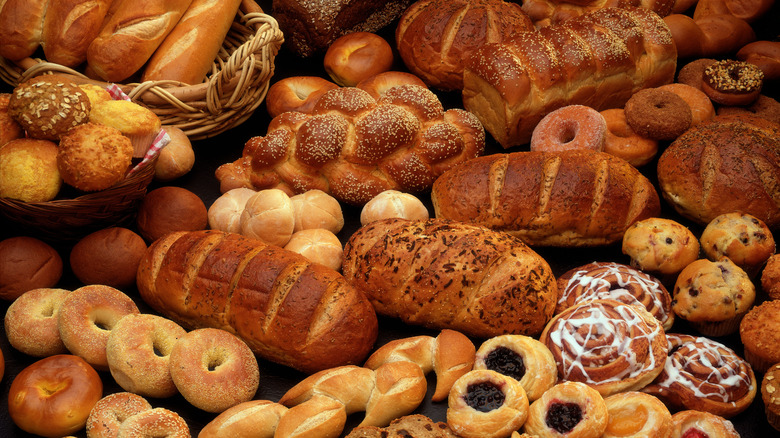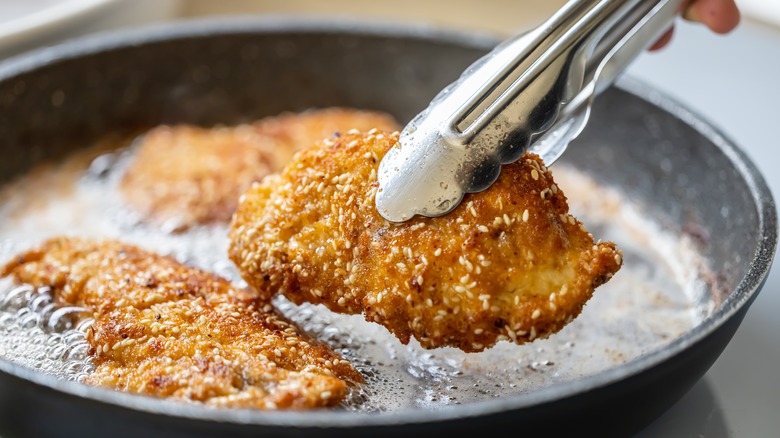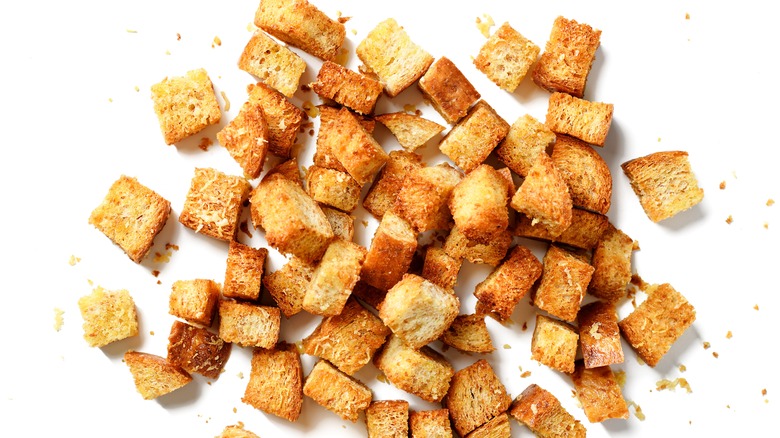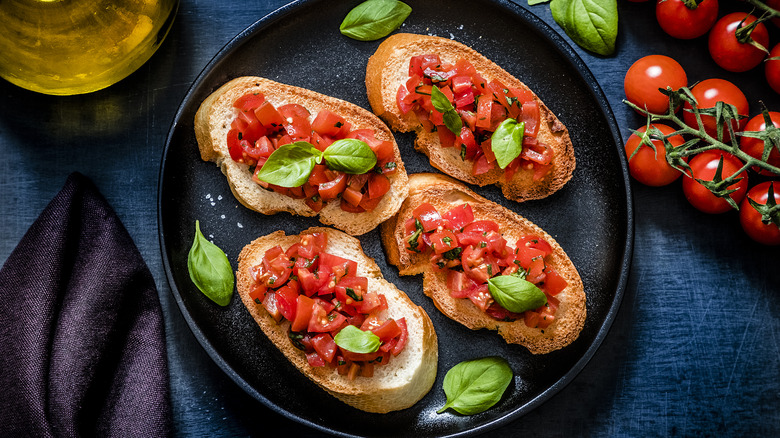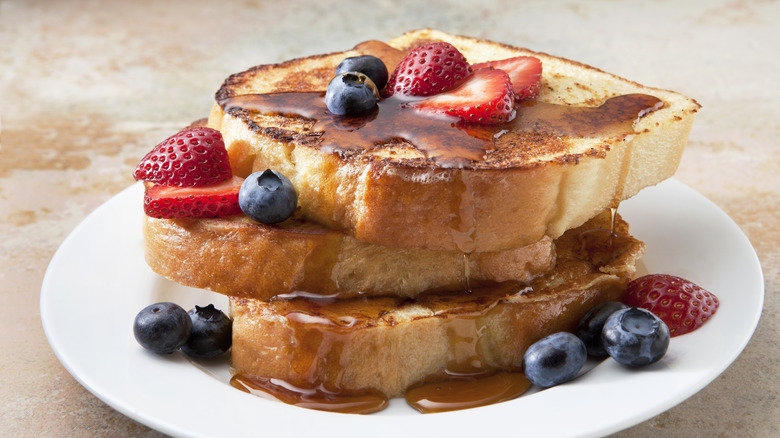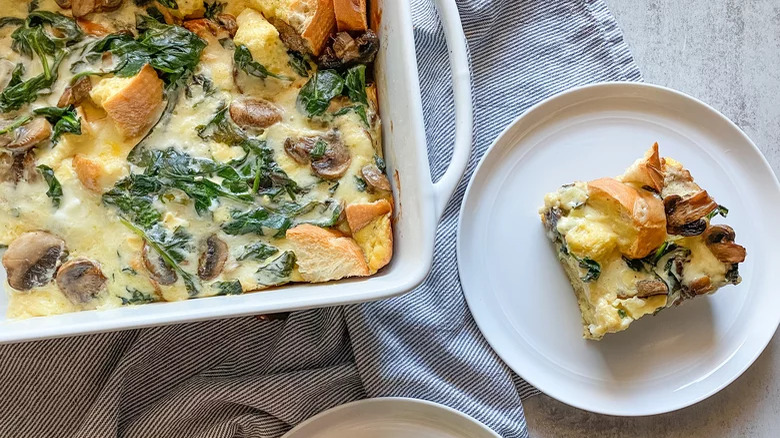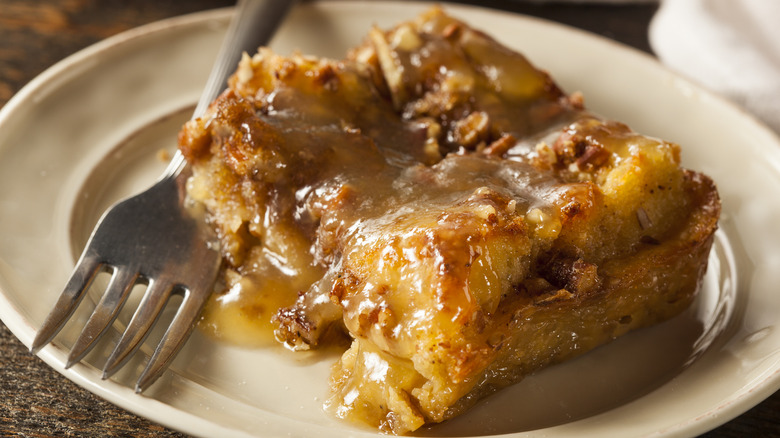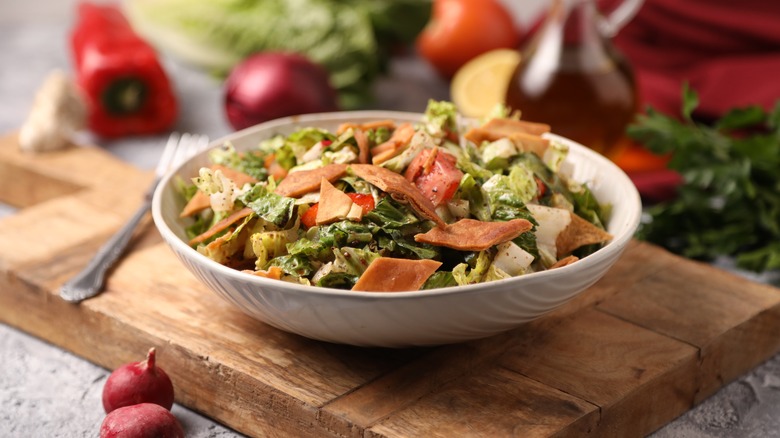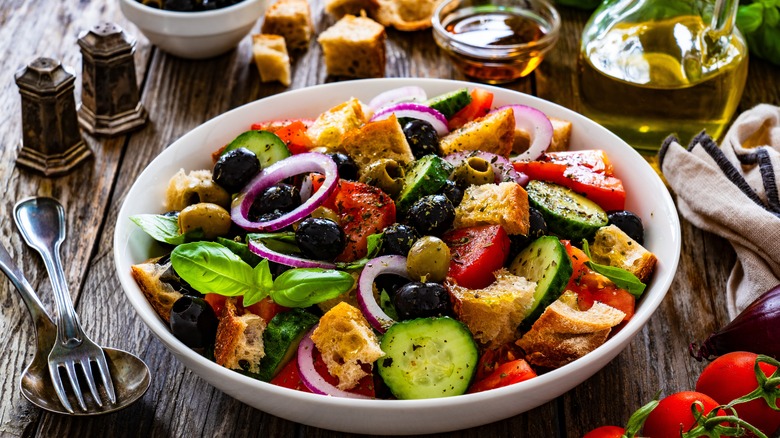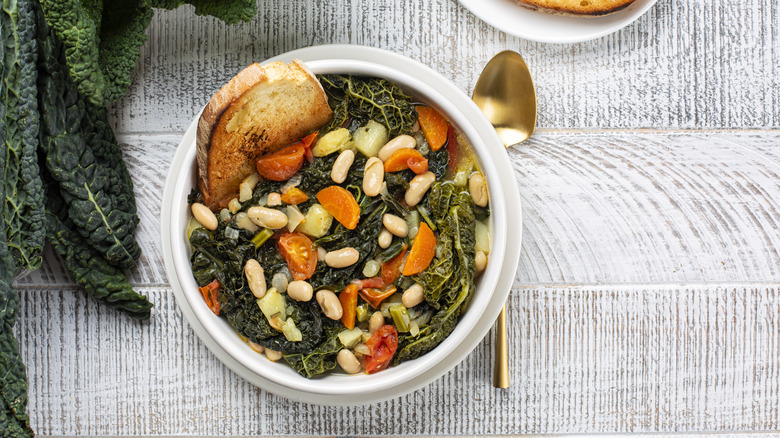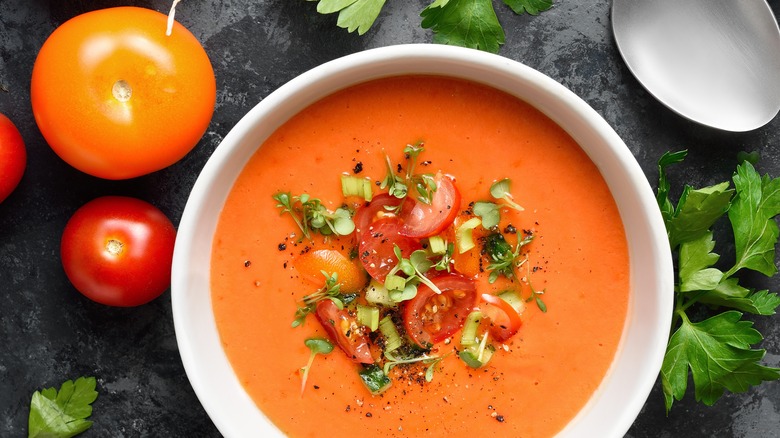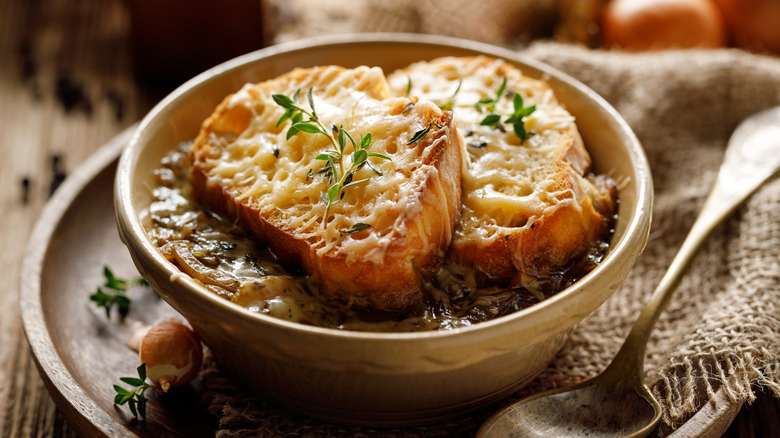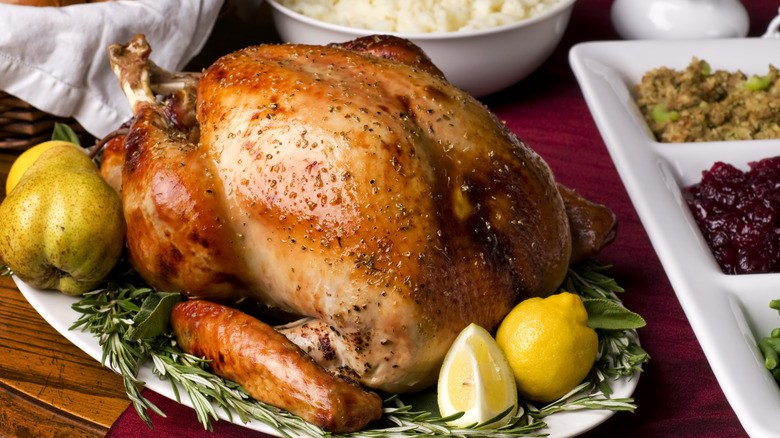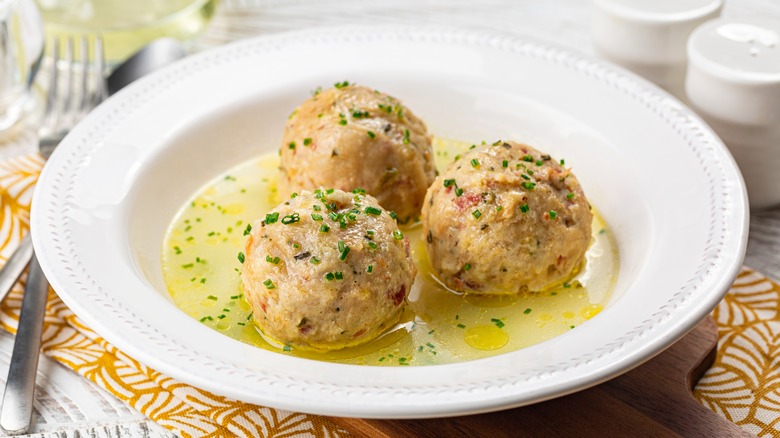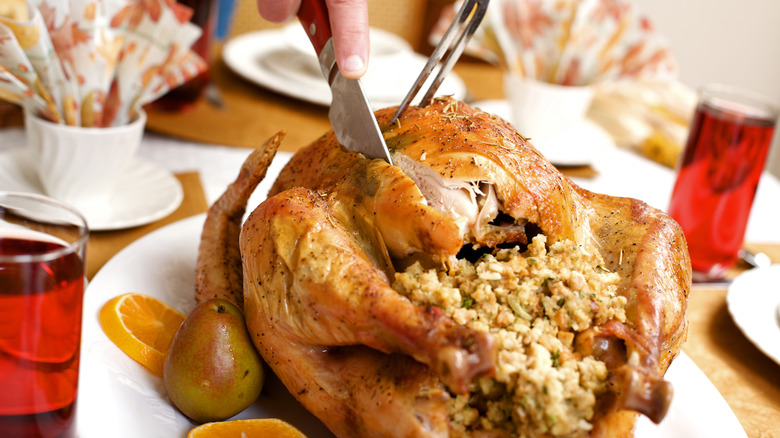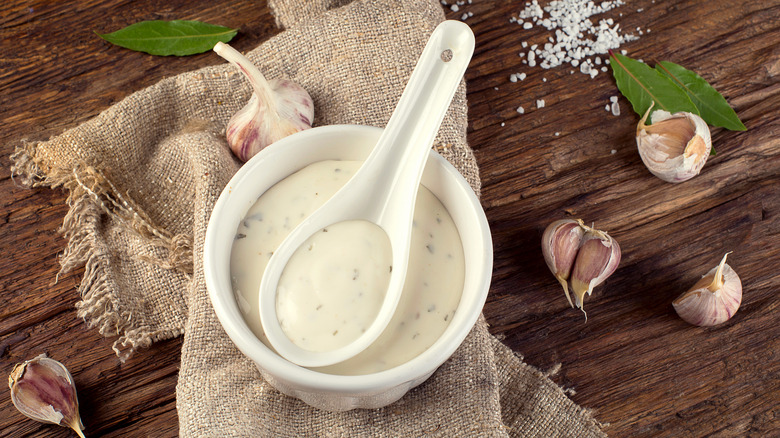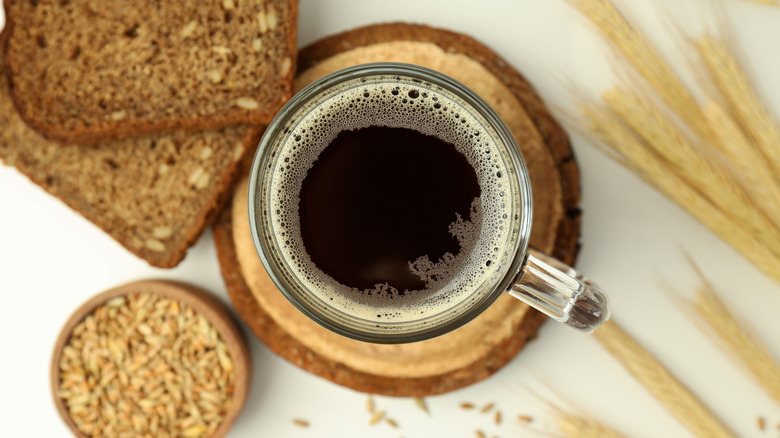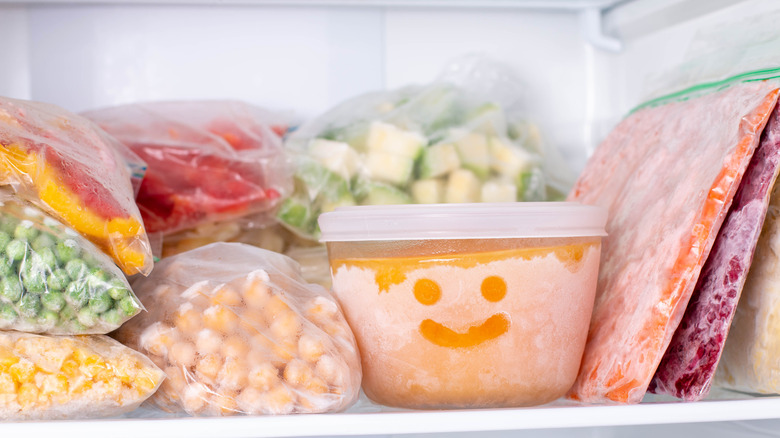17 Ways To Use Up Leftover Bread
How disappointing is it to find that the loaf of bread you lovingly baked or selected from your neighborhood grocery store has gone a bit too tough to enjoy? Rather than toss it, top chefs and experienced home cooks know there's a wealth of ways you can repurpose into just as delicious concoctions.
But before you even get to this point, for chef Chris Edwards, it's important to care for your bread from the outset. "Bread must be listened to," he says. "It doesn't wish to be sweating in a plastic bag, and it doesn't really want to be sliced too early if that can be helped."
Bread, especially those that aren't chock-full of additives and preservatives actually have a fairly short shelf life, according to Ellen King, co-owner of Hewn Bread in Evanston, Illinois. "Bread if wrapped and stored on the counter should last up to 4 to 5 days." Sourdough may last you a bit longer, given its acidity, which, she says, acts as a natural preservative. But after this window, she says, the bread will either become moldy or stale. And while moldy bread isn't something you want to repurpose, seeing as it is now filled with mycotoxins that are harmful to humans, we can definitely get on board with upcycling stale bread.
While for Edwards, bread is never "really wasted" if any leftovers are composted, before you get there, here are some delicious ways to repurpose a stale loaf.
Make homemade breadcrumbs
Perhaps one of the easiest, most time-tested ways of preserving stale bread is by transforming it into bread crumbs. For King, this is best done with bread that has gone "completely stale (meaning no soft bits at all)."
To transform stale bread into bread crumbs, simply break the bread into chunks or slice it using a serrated knife, taking great care not to accidentally cut yourself, especially if the bread is quite hard. Place these cubes into a food processor, and pulse until you've got the size and texture you seek. The bread crumbs can be stored in an airtight container in the fridge for a week or frozen for up to four months. You can also dry out your bread crumbs at 250 degrees for about 15 minutes or so, which will allow you to keep them at room temperature in an airtight container for about two weeks.
The resulting bread crumbs can be used in all manner of dishes, from your favorite chicken parm to a tasty breaded cod recipe. Toast them with butter and herbs to form a quick bread crumb gremolata that makes a delicious garnish atop soups or salads, or use them to thicken a filling for stuffed tomatoes.
Make your own croutons
If you're still buying packaged croutons from the supermarket, the time has come to change things up. Croutons are so easy to make at home, and when you use quality bread, the store-bought stuff just can't compete.
To make homemade croutons, simply cube the stale bread and toss it with oil and your choice of seasonings. Rosemary or thyme are great options, seeing as they won't shrivel or wilt in the oven. Powdered garlic will punch up the flavor considerably, and sweet or smoked paprika could lend a lovely pop of color and brightness. Once the croutons are well-coated in the seasonings of your choice, all it takes is a quick trip through the oven for these croutons to be ready to enjoy, just as long as you keep a close eye to keep them from burning.
As for how to use them, the possibilities are endless, though it's hard to beat a classic homemade Caesar salad. Edwards also loves placing a few croutons "in the bottom of a bowl to receive a soup or stew." They'll soak up the broth to become even more flavorful by the time your spoon finds them!
Transform stale bread into a base for seasonal bruschetta
The very word bruschetta comes from the Italian word bruscare, which translates to "to roast over coals." This summery appetizer sees slices of grilled or toasted bread rubbed with garlic and drizzled with olive oil before being piled high with tomatoes. It's the ideal recipe for using up slightly stale bread, especially the unsalted Tuscan variety, according to Edwards: Since the topping is so flavorful, it really punches up the flavor of the bread, and using bread with a bit less moisture keeps the little toasts from falling apart the moment they are piled high with the juicy tomato topping.
Speaking of which, while classic bruschetta certainly loves tomatoes, there are loads of ways you can play with this traditional recipe. Apples, brie, and honey make a particularly delightful bruschetta topping, as do seasonal strawberries with mascarpone and balsamic vinegar. Or invite bruschetta's cousin crostini to the party, piling rounds of toasted bread high with steak, figs, and red wine jam.
Soak it in custard to make French toast
In French, the word for French toast is pain perdu, or lost bread, a term that offers a hint at how it got its start. French toast is indeed one of the most classic after-school snacks in France, the perfect way to repurpose any stale baguette from that morning's petit déjeuner.
King prefers two-day-old bread for French toast, at which point it is tender enough to remain pillowy and soft, but dry enough to soak up all that luscious custard.
Any bread will work for French toast, though there's a reason so many opt for rich brioche, which transforms the subsistence recipe into a true treat. Edwards also loves using Gâche de Vendée, an enriched bread with a slightly tighter crumb than brioche. "Though requiring a delicate touch," he says, it "makes a lovely pain perdu." Whatever base you choose, topping French toast with fresh berries and maple syrup is a no-brainer.
Transform stale bread into a savory strata
Think of strata as French toast's savory Italian cousin. Made by combining bread cubes with a savory custard and all manner of fillings, it's the ideal brunch bake or easy weeknight dinner that can come together in as few as 30 minutes.
Recipe developer Kristen Carli makes her strata recipe with mushrooms, spinach, and sharp cheddar cheese. And for her, stale bread is a must. "It is firm and will soak up the liquid from the eggs and the cream," she says.
Edwards, meanwhile, cites a "wonderful" version of this dish from celebrity chef Michel Roux, made with layers of egg-soaked bread, bacon, cheese, and herbs, "assembled and left to acquaint with each other for 48 hours before being baked," Edwards explains, for a dish Roux dubs "French toast eiderdown."
"I have a great love for this dish," says Edwards, "though do think the word eiderdown is used here in the manner of a heavier quilt rather than a lighter summer couverture."
Bread pudding
What French toast is to France and strata is to Italy, bread pudding surely is to England. Invented during the Middle Ages, when it was known as "poor man's pudding," bread pudding surged in popularity once more during the austerity of World War II, as it was an inexpensive and delicious way to make use of what table scraps were left.
Making bread pudding begins much as French toast or strata do: Leftover bread is soaked in custard before being baked. While it's lovely sweetened with just a bit of sugar and cinnamon, bread pudding also welcomes add-ins to render it even more delicious. Simple raisins are a classic choice, whether soaked in rum or not, but dried cherries and pecans make a delicious sweet-and-savory version as well. You can even gild the lily with butter, as in another British tradition: bread and butter pudding, or top the bread pudding with homemade butterscotch or brandy sauce for an even richer treat.
Transform leftover pita into fattoush
In Lebanon, if you've got leftover pita hanging around, there's no question what you'll do: transform it into fattoush. This salad is tailor-made for using leftover bread, as its name suggests; fattoush, after all, is Arabic for "little bread crumbs." Toasted in oil or butter, pita provides a lovely crunchy counterpart for the other ingredients in the salad, which may include lettuce, bell pepper, cucumber, radish, scallion, tomato, or fresh herbs. A dressing of olive oil, lemon juice, and wine vinegar seasoned with garlic is all you need for these ingredients to sing, though they'll be even tastier if you sprinkle on a little sumac, a beloved spice in the Middle East that offers a pop of bright acidity.
While fattoush is usually vegetarian, you can also bulk it up by adding grilled chicken or steak. And if you'd like a touch of sweetness, a drizzle of pomegranate molasses will kick these flavors up to 11.
Transform stale bread into panzanella
Much like fattoush, panzanella is a salad combining cubes of day-old bread with seasonal ingredients. The most traditional version hails from Tuscany, where bread is famously unsalted, a particularity legend says stems from the fact that salt was once such an expensive commodity that the poor couldn't afford to add it to their bread. But panzanella more than makes up for the lack of seasoning in this staple, marrying it with seasonal summer tomatoes, cucumbers, fresh herbs, red onion, oil, vinegar, and anchovies for a kick of salinity and brine.
While a summer panzanella is certainly the most traditional iteration of this dish, it's not the only way you can imagine this salad taking form. In autumn, why not add roasted squash to your panzanella, or come winter, take a page out of recipe developer Sher Castellano's book and pair the toasted cubes of stale bread with the vibrant colors and flavors of oranges, radicchio, and fennel? You can even make panzanella with roasted vegetables to transform the refreshing salad into a warming comfort food main that will have you forgetting its cucina povera status.
Soak stale bread in ribollita
The Tuscans prove nothing if not masterful with their approaches to stale bread, as ribollita surely shows. This flavorful soup's name translates to "reboiled," a sure evocation of its origins as a means of repurposing leftovers into something just as delicious. Ribollita begins with a richly flavored broth in which you'll simmer loads of vegetables, protein-rich cannellini beans, and leafy Tuscan kale. Toasted cubes of crusty Italian bread lend substance to the soup, soaking up the liquid to become little pillows of flavor.
Making ribollita is also a great way of using up yet another potential waste ingredient: Parmesan rinds. The harder exterior of your parm may not be good for grating, but if you toss it in this soup as it simmers, it will imbue the broth with even more rich flavor. Store the rinds well-wrapped in the fridge or freezer so that you have them on hand whenever the mood for ribollita strikes.
Blend stale bread into Andalusian gazpacho
Yet another soup that traditionally relies on the thickening power of bread hails from Spain. Gazpacho's very name is derived from the Arabic for "soaked bread," a reference to the way in which stale bread or bread crumbs may be soaked in a mixture of tomato, garlic, olive oil, vinegar, onion, cucumber, and green pepper. (With all those veggies, it's perhaps no surprise that in Spain, this "soup" is technically categorized as a salad!)
Nevertheless, for non-Spaniards, there's something distinctly soupy about the chilled, puréed mixture, which is traditionally served with even more stale bread in the form of croutons, not to mention other garnishes like chopped vegetables or boiled eggs. And while there may be as many gazpacho recipes as there are cooks, many rely on the rich aroma of sherry vinegar and the pungency of a pinch of cumin to help all those fresh veggies sing.
Settle a round of stale baguette on a bowl of French onion soup
Much like Italy and Spain, France has its own version of a soup that takes full advantage of stale bread. French onion soup is, as its name suggests, a soup with a base of deeply caramelized onions simmered in broth until the flavors have mingled and married. Traditionally crowned with a round of stale bread, the soup is then topped with a heaping helping of grated cheese and broiled until bubbly.
French onion soup ostensibly got its start in the former "belly of Paris," the Les Halles market, where des hommes forts (literally: strong men) who unloaded shipments of food in the wee hours would enjoy it as a late-night or early-morning meal at one of several 24-hour restaurants that still dot the area where the now-defunct market once stood. And while the pairing of onion, bread, and cheese is a classic, Edwards notes that such treatment is "not limited to French onion, if that could ever really be considered a limiting factor." Consider floating a round of cheese-topped bread on your tomato soup for a unique play on the classic pairing with grilled cheese.
Turn stale bread into a bread sauce perfect for roast chicken
If you grew up in the U.K., chances are your Christmas meal included bread sauce, which Edwards asserts is "of Middle Ages zero waste origins." Think of this savory sauce like a thicker cream gravy. It's made with stale bread simmered in milk, which may be infused with savory aromatics like onion and garlic, but also with sweeter spices like clove or herbal bay leaves. In this recipe, leftover bread serves as a thickener — a bit like a roux — for a resulting sauce that's rich, thick, and almost creamy.
Bread sauce is perfectly paired with roasted poultry like turkey, which most Brits enjoy as the centerpiece of their Christmas meal. That said, you could easily pair it with a smaller bird like a roast chicken and enjoy the benefits of bread sauce any day of the week. Either way, cranberry sauce is a welcome addition to the party for a touch of brightness.
Transform leftover bread into dumplings
If the word "dumplings" makes you think of either stuffed wontons or family favorite chicken-and-dumplings recipe, may we offer another contender — and this one a food waste champion? Bread dumplings are a popular creation in many Central and Eastern European countries, from Germany to Czechia. What the Germans call Semmelknödel typically sees leftover bread used as a bulking agent for a mix of savory custard seasoned with bacon, fresh herbs, pepper, and nutmeg. The Czech version is far plainer, pairing bread with a batter made from flour, eggs, milk, baking powder, and salt.
Either way, these dumplings are tailor-made for soaking up any kind of gravy. Pair them with classic German sauerbraten or serve alongside your favorite soup recipe to scratch the starch itch with something a bit more unusual than classic mashed potatoes or toast. If you want these dumplings to be the star of the show, meanwhile, all they need is to be simmered in a bit of broth and garnished with fresh herbs.
Transform stale bread into the perfect turkey stuffing
Perhaps the most all-American answer to the question "What do I do with all this leftover bread?" is, of course, to make stuffing. A Thanksgiving staple, stuffing was tailor-made for using up stale bread, seeing the cubed chunks soaked in a richly flavored broth. Stuffing recipes run the gamut, ranging from super-quick stovetop versions seasoned simply with alliums and celery to iterations boasting richer flavors like savory sage sausage paired with sweet apple. Some stuffings are baked in a casserole dish, while others are quite literally stuffed into the bird, where they can absorb all of the juices as the turkey roasts.
Should you opt for the latter method, however, a word of warning: Experts say that roasting a stuffing-stuffed turkey may result in issues of food safety. Both turkey and stuffing must hit 165 degrees Fahrenheit to be considered safe for human consumption, and often, by the time the stuffing reaches that perfect number, the turkey is already overcooked. If you can't imagine a turkey without the stuffing, there are a few safety guidelines you can hew to, including stuffing the turkey right before roasting it and avoiding overstuffing: About 15 cups of stuffing is the upper limit for a 20-pound turkey. To be extra cautious, consider removing the stuffing before carving and finishing it off with a few extra minutes in a hot oven, which won't just kill off any lingering pathogens but will also give you a lovely crispy topping.
Transform stale bread into a thickening panade
Unlike some of the other options on this list, panade is less of a recipe unto itself than a base one can use for myriad other preparations. A paste made of milk and bread, panade is the perfect base to keep your meatballs moist or to thicken a stubborn aïoli, typically thickened solely by way of the emulsifying powers of egg yolk or garlic alone.
When using panade to add moisture to meatballs or meatloaf, use half the volume of panade for each volume of meat. If you're using it to thicken homemade aioli, about 180 grams of bread (about six ounces, or five cups, give or take) will provide structure for a recipe made with one egg, one egg yolk, and about ½ cup of oil. The panade itself should be made of equal amounts of stale bread and milk, which are soaked together before being mashed with a fork or spoon.
Ferment leftover rye bread into kvass
Many recipes for using leftover bread can absorb nearly every flavor and style, from walnut-studded sourdoughs to simple sliced sandwich bread. But if you've specifically got rye bread hanging around, you've got the cornerstone of one of the most time-tested recipes for leftover bread hailing from eastern Europe. Kvass isa fermented, slightly alcoholic beverage you'll find often in Russia and Ukraine. In the same tradition as kombucha or kefir, this fermented beverage offers a gut-friendly blend of probiotics and a pleasant sour flavor that some temper with the addition of sweet beets.
Making your own kvass at home does involve some time and prep, but it's not difficult by any means. You'll need to ferment the bread with water, a touch of sugar, and raisins for about three to five days, at which point your brew will be ready to enjoy. Don't worry — it's well worth the wait!
Freeze stale bread so that you can use it later
If you know from the outset you won't be able to eat your whole loaf before it goes off, Edwards notes he often avoids food waste from the outset by freezing slices of bread "toaster ready."
"I freeze bread all the time," echoes King. "I love bringing home a loaf, slice it and freeze it in a freezer-safe bag. I pull a piece for toast each morning."
That said, a word of warning: Edwards notes that after a week or two in the freezer, frozen bread slices may get freezer burnt, making them far from the most pleasant base for your morning avo-toast. If you're planning on freezing bread for longer than that, it's best to do so in the form of bread crumbs, which can be toasted in butter when they come out of the freezer. It's hard for anything to taste bad once it's been toasted in butter!
